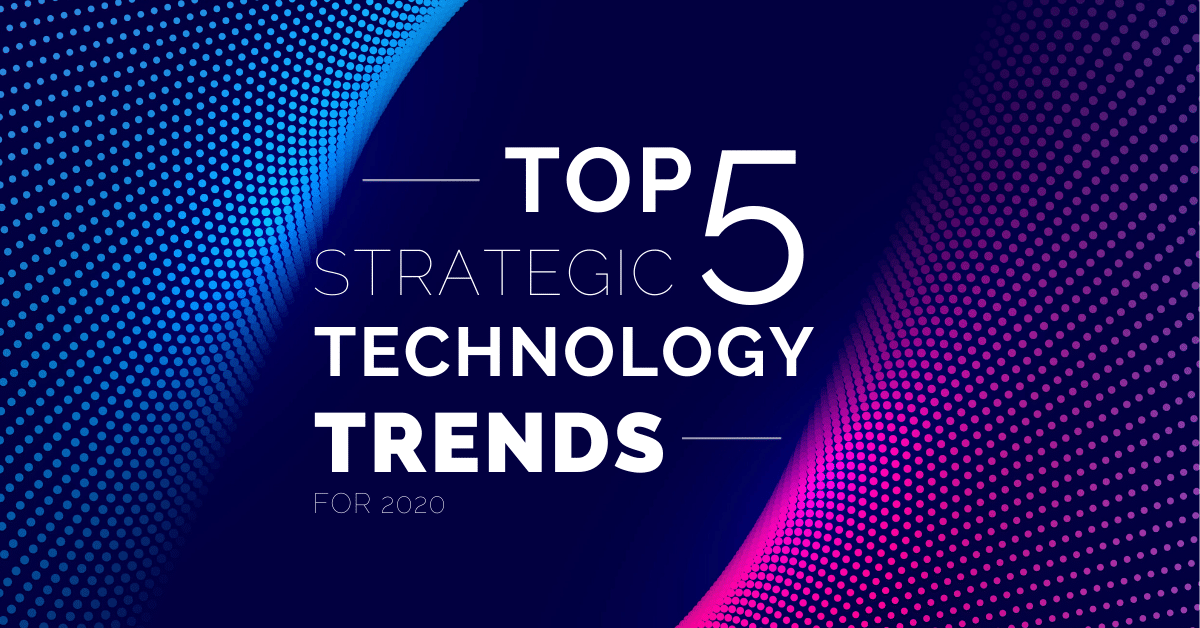The following strategic technology trends for 2020 have the potential to both create opportunities and drive significant disruption.
Enterprise architecture and technology innovation leaders must evaluate these top technology trends to determine how combinations of technology trends can power their innovation strategy.
They have the potential to significantly create and respond to disruption and to power both transformation and optimization initiatives.
Artificial Intelligence (AI) is having an impressive role when it comes to advanced process automation and human augmentation and engagement, considering that it will become critical to maintain trust in terms of security, privacy, and digital ethics.
We will experience new forms of workspace adaptation in factories, offices, and cities through multiple touchpoints and sensory channels for an increasingly ambient experience, called “smart spaces”.
This article is based on Gartner’s “Top 10 Strategic Technology Trends for 2020” Special Report, which states that technology leaders must embrace multi-experience and implement innovative platforms to support conversational and immersive ambient experiences, best practices, policies, and technology architecture to increase transparency and trust regarding data and the use of AI.
Innovation leaders need to examine the impact of these trends on their businesses to seize opportunities to create or enhance existing processes, products or business models because it will dramatically change technologies related to them to 2025 from now, so let’s begin:
1. Hyperautomation
Automation refers to the use of technology to facilitate or perform tasks that originally required some form of human judgment or action. The term “tasks” refers not only to tasks and activities in the execution, working or operational environment, but it also encompasses tasks in thinking, discovering and designing these automations themselves.
Hyperautomation refers to the combination of multiple machine learning, packaged software, and automation tools to deliver work.
The propensity to use particular types of automation will be highly dependent on the organization’s existing IT architecture and business practices. It also refers not only to the breadth of the pallet of tools but also to all the steps of automation itself (discover, analyze, design, automate, measure, monitor, reassess).
Hyperautomation requires the selection of the right tools and technologies for the challenge at hand, like Robotic Process Automation (RPA) and Intelligent business process management suites (IBPMSs).
Understanding the range of automation mechanisms, how they relate to one another, and how they are combined and coordinated, is a major focus for hyperautomation. They are highly complementary.
2. Multiexperience
Conversational platforms are changing the way in which people interact with the digital world. Virtual reality (VR), augmented reality (AR) and mixed reality (MR) are changing the way in which people perceive the digital world. This combined shift in both perception and interaction models leads to future multisensory and multitouchpoint experience.
The “computer” in a multiexperience world is the environment around the user, including many touchpoints and sensory inputs. The multitouchpoint aspect of the experience will connect people across edge devices, including traditional computing devices, wearables, automobiles, environmental sensors, and consumer appliances.
The multisensory aspect of the experience will use all human senses as well as advanced computer senses (such as heat, humidity, and radar) as appropriate across this rich sea of devices. In the future, the very notion of “computer” will seem like a quaint and antiquated idea as the spaces that we inhabit become multisensory and multitouchpoint interfaces.
The long-term manifestation of multiexperience is also called the ambient experience. However, this will happen only slowly through 2029 and beyond.
The best practice for providing an optimized experience is to build connected, fit-for-purpose apps that align the design, function, and capabilities of the app to individual personas and modalities.
3. Democratization
Democratization is focused on providing people with access to technical expertise (e.g., machine learning, application development) or business domain expertise (e.g., sales process, economic analysis) via a radically simplified experience and without requiring extensive and costly training. The notion of “citizen access” (e.g., citizen data scientists, citizen integrators) as well as the evolution of citizen development and no-code models are examples of democratization.
The development of expert systems or virtual assistants based on AI and decision models is another important aspect of democratization. These systems provide advice or take actions on behalf of people to extend their knowledge or expertise beyond their experience or training.
It is important to note that the target for the democratization trend could be any person inside or outside the enterprise including customers, business partners, corporate executives, salespeople, assembly line workers, professional application developers, and IT operations professionals.
There are four key aspects to the democratization trend that are accelerating in 2020 through 2023:
– Democratization of Application Development: AI PaaS provides access to sophisticated AI tools to leverage custom-developed applications. These solutions provide AI-model-building tools, APIs and associated middleware that enable the building/training, deployment, and consumption of machine learning models running on prebuilt infrastructure-as-cloud services.
These cover vision, voice, and general data classification and prediction models of any type.
– Democratization of Data and Analytics: The tools used to build AI-powered solutions are expanding from tools targeting data scientists (AI infrastructure, AI frameworks and AI to tools targeting the professional developer community (AI platforms and AI services) and the citizen data scientist. This includes tools to generate synthetic training data, which helps address a substantial barrier to ML model development.
– Democratization of Design: In addition, low-code application development platform tools used to build AI-powered solutions are themselves being empowered with AI-driven capabilities that assist professional developers and automate tasks related to the development of AI-enhanced solutions.
This expands on the low-code, no-code phenomenon with the automation of additional application development functions to empower the citizen developer.
– Democratization of Knowledge: Non-IT professionals increasingly have access to powerful tools and expert systems that empower them to exploit and apply specialized skills beyond their own expertise and training. Dealing with the issues around “shadow AI” in this user-led environment will be a challenge.
4. Distributed Cloud
This refers to the distribution of public cloud services to different locations outside the cloud providers’ data centers, while the originating public cloud provider assumes responsibility for the operation, governance, maintenance, and updates.
This represents a significant shift from the centralized model of most public cloud services and will lead to a new era in cloud computing. Cloud computing is a style of computing in which elastically scalable IT-enabled capabilities are delivered as a service using Internet technologies.
Private cloud refers to the creation of cloud-style services dedicated to individual companies often running in their own data centers. Hybrid cloud refers to the integration of private and public cloud services to support parallel, integrated or complementary tasks.
Hybrid IT and true hybrid cloud options can be valid approaches, and Gartner recommends them for certain critical use cases. However, most hybrid cloud styles break many of the cloud computing value propositions, including:
– Shifting the responsibility and work of running hardware and software infrastructure to cloud providers
– Exploiting the economics of cloud elasticity (scaling up and down) from a large pool of shared resources
– Benefiting from the pace of innovation in sync with the public cloud providers
– Using the cost economics of global hyperscale services
– Using the skills of large cloud providers in securing and operating world-class services
5. Last but not least of our Strategic Technology Trends for 2020: AI Security
Over the next five years AI, and especially ML, will be applied to augment human decision making across a broad set of use cases. At the same time, there will be a massive increase in potential points of attack with IoT, cloud computing, microservices and highly connected systems in smart spaces.
While this creates great opportunities to enable hyperautomation and leverage autonomous things to deliver business transformation, it creates significant new challenges for the security team and risk leaders.
There are three key perspectives to explore when considering how AI is impacting the security space:
– Protecting AI-powered systems: This requires securing AI training data, training pipelines and ML models.
– Leveraging AI to enhance security defense: This uses ML to understand patterns, uncover attacks and automate aspects of the cybersecurity processes while augmenting the actions of human security analysts.
– Anticipating nefarious use of AI by attackers: Identifying these attacks and defending against them will be an important addition to the cybersecurity role.
Prepare for the impact of these technology trends. They will transform industries and businesses.






